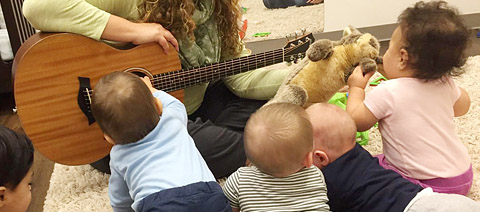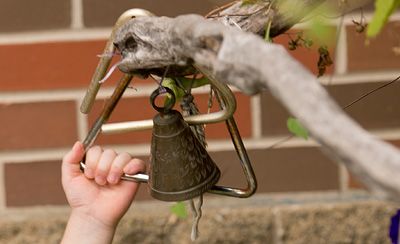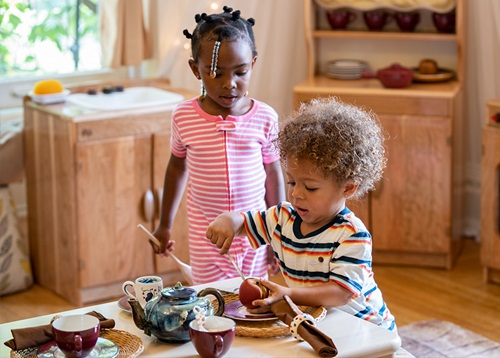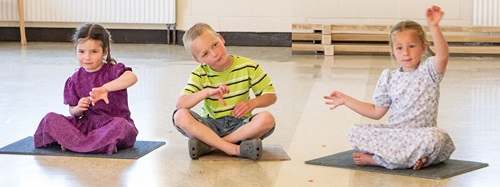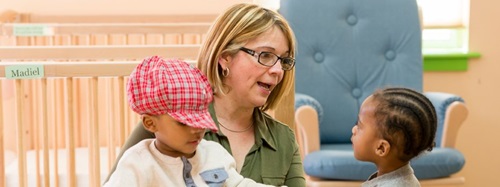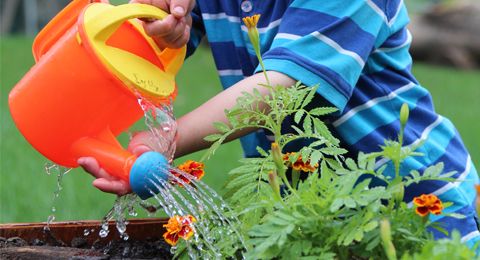Creating a Soundscape for Young Children
| April 2016Babies are born listeners, attuned to sounds in the womb and the world. Before their vision sets in, infants know their environment through sound—a parent’s lullaby, a dog barking, water in the bathtub, and if they’re lucky, the pulsing rhythms of music. The landscape of sound, a child’s soundscape, is ever present. Touch, smell, and sound are baby’s first teachers.
Adults tend to take sound for granted so it rarely finds a place in our early childhood curriculum. Rather, we think primarily about MUSIC which involves performance, talent—you know, what music teachers do. But for young children, all sound is fascinating, from the random siren to the frolicking fiddle. They are experiencing the world anew, it’s all amazing.
Early childhood teachers are intentional in creating physical environments for children, but we often overlook the soundscape, not realizing it is there. How can we do better? First, we need to envision sound as a learning domain. Second, we must build confidence to present sound and music so we can support the learning.
Children are fascinated by objects that produce sound.
For the last ten years, I have been helping teachers build music programs in early learning centers. I’ve helped them recognize children’s curiosity and extend exploration through materials and experiences. There are generally two challenges for teachers—bad childhood memories around music and a sense of not knowing where to start. Education programs don’t provide teachers with the practical tools we need—lists of materials and songs, role models during student teaching. We allow the once-a-week music specialist to define the soundscape, missing opportunities for learning. Teachers with math anxiety count, measure, build, bake, and play math games at school. Musically fearful teachers can do music too.
Teacher as Facilitator
This isn’t about you, your voice or your talent. You are a facilitator for the children to make discoveries, not a performer. You bring people together to be with sound and song; you give children a platform for exploration. To get started you need to:
1. believe that sound and music are central to learning,
2. know that children are not judging teachers,
3. acknowledge that musical learning takes many forms and may surprise us,
4. use props such as instruments and books,
5. allow music to expand the curriculum and inspire new directions.
Once you commit to being a sound facilitator, set up your classroom to nurture inquiry. I hope you will follow the steps in this article to create a compelling and pleasurable musical environment with your students. You don’t need any special expertise.
A Step by Step Guide
1. Defining a Soundscape
When we talk about soundscapes, we mean more than songs. The soundscape refers to the overall presence of sound in your room—intentional and unintentional noise, music, your voice giving directions, a PA system, pencil tapping, even an annoying radiator. All sound is present even if you don’t realize it’s there.
2. What We Already Do
Most of us transition children with song and play soft music at rest time. Why do we make these choices? Instinctively, we know music establishes mood and can shift children quickly. A simple bell played at the same moment each day lets children know what comes next. By using music as a non-verbal cue, you help children regulate themselves.
You can orchestrate a musical mood in the room throughout the day. Soft harp music by Theresa Honey upon arrival at school, dancing to James Brown to let off steam, a Bach sonata during work time. Trust that if the music makes you feel good, energized, or sleepy the children will respond similarly.
All of us read to children every day. Expand this practice to include illustrated songbooks. Many teachers find these books launch them into song with confidence, The Wheels on the Bus or Old MacDonald Had A Farm are great starters. YouTube is a wonderful resource for learning new songs and links can be shared with parents for singing at home.
3. What Do Musical Learners Look Like?
Spend time observing children. How do they use their hands? Are they always playing the drum? Teachers can tell when children have a lot of exposure to writing materials at home by noting a mature grip or preference for the art area. Similarly, a child who has access to instruments at home will exhibit fluency patterns and heavy engagement at school. Get to know your kids through their choices during work time.
Sometimes our beliefs about audience behavior blind us from seeing real learning. We think that children sitting and singing are the only standard for success. Let’s shift our expectations. When children are listening they don’t always look like they’re learning. Depending on their age (or temperament) kids might squirm, do a puzzle, read, or walk around. Children with special needs often benefit from music the most, as a time to relax and let off steam or retreat into themselves. They are learning about music too.
Remember, children build receptive language as they live life, and that’s how they grow musically too. The quiet or “distracted” child may go home at night and sing songs in the bathtub. They may be silent for several months (like English Language Learners) and suddenly blossom. Emotions in music help children name feelings and grapple with those they can’t identify.
Music is an unparalleled tool for teaching self-regulation: start and stop, slow and fast, soft and loud, languid and choppy. The learning is non-verbal and so natural we don’t realize it is happening.
Don’t feel slighted when children do their own thing during music. It’s not a reflection of your performance. The children are learning, each in their own way.
4. Our Materials
Musical libraries are the most important tool for creating a sound experience with children, as everyone is comfortable with books. Libraries include several categories:
- illustrated songbooks,
- rhythmic or rhyming books,
- fiction on musical subjects,
- alphabet books,
- books with guitar/piano music, and
- dictionaries with images of instruments.
All of these serve different purposes, but illustrated songbooks are your most important teaching tool. These books help you establish a culture of singing as a group, scaffolding children as they begin to learn to read. They help us remember lyrics and the tune; they are a focal gathering point. The goal is independent use, with children singing songs alone or in small groups. The children can make their own songbooks too. Keep the musical library in its own basket to distinguish the collection. If you’d like a comprehensive bibliography please contact me directly at reneebock1818@gmail.com.
Instruments are important in a musical room, as children need to touch objects to learn how they work. Rhythm sticks, tambourines, finger drums, shakers, and bells are all staples. Keep them in separate baskets. You might have a song where everyone plays the tambourine. Or, each child gets something different. Make instruments accessible. Switch off between block days and music days to control the noise level.
Invite musicians from your neighborhood to class. Children will notice that percussion, woodwind, and string instruments work and sound differently. An old violin sitting in someone’s closet is a great teaching tool, even if no one plays well. But of course, hosting a live musician is optimal.
Instrument explorations open doors to scientific inquiry. How do instruments work? Why are they high and low? Big and small? Why is the hole on the guitar different from the violin? Why do they even have holes?
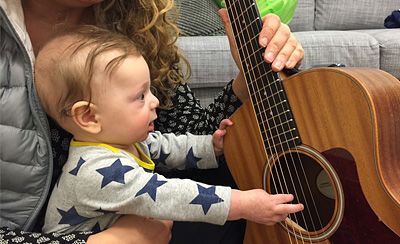
Exploring instruments open doors to scientific inquiry.
Music encourages language growth as well. I recently worked with a group of eighteen-month-olds who wondered what animals lived inside my guitar. Could an elephant fit? A bird? We developed a bird house curriculum, an organic, complex, study for two year olds.
Develop an IPod playlist introducing children to performers from around the world. If students are interested in guitar, play Django Reinhardt, Elizabeth Cotton, Andre Segovia and Jimi Hendrix. Older children will be interested in their stories, how Reinhardt and Cotton developed unusual techniques (two fingers and left hand) out of challenges. Cultural diversity, invention, persistence—are all values taught through music.
5. Moving Forward
There’s nothing I can say to make you comfortable singing. You simply have to take the leap. The more you do it, the more natural it becomes. If one of the teachers in your room feels more confident leading, let them lead. What’s really important is that teachers support each other enthusiastically. When teams work with intention the children know we care. If we use music time to clean the room, put out snack, or make a call, children and adults disengage.
Center directors set the tone for the school’s values. As a leader, you can shape a music program by allocating resources and being a role model. Budget for books, instruments, guitars, and even guitar lessons. Let teachers know you support a sound curriculum. Occasionally lead some songs. Your participation establishes a school identity.
As children’s first teachers (and models for parents) we need to raise awareness of their need, in fact their right, to early experiences with music and sound. Every day children should join together as a musical community; it feels good and makes school a happy place to be. Your classroom environment and your presence as a role model, set the stage for deep learning. By offering children the world of sound, you open doors of possibility for a lifetime of joyful participation. At the core, that is what early childhood education is really all about.
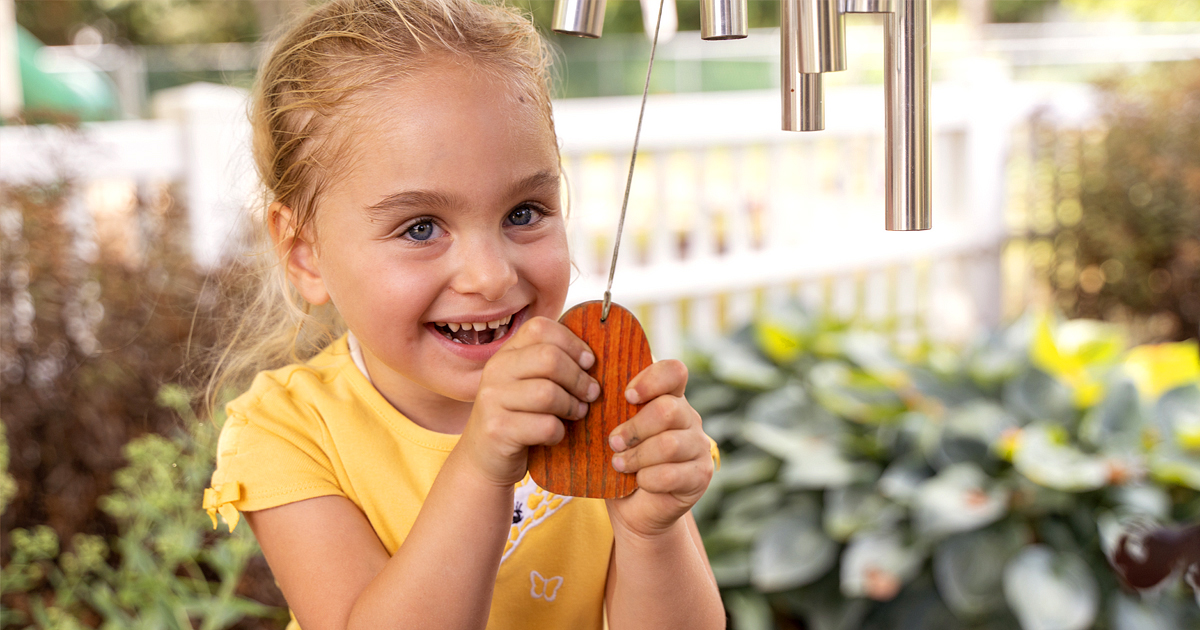
Creating intentional Soundscapes opens new doors to learning.
Resources
Blogs by Renee:
http://www.newyorkfamily.com/music-before-words
http://www.newyorkfamily.com/the-magic-of-babies-inner-musical-universe
http://wellroundedny.com/singing-with-babies
Interesting Articles:
http://rsos.royalsocietypublishing.org/content/2/10/150221
Recordings:
1) Pete Seeger’s Birds, Beasts, Bugs and Fishes (Little and Big)
2) Smithsonian Folkways Children’s Collection
3) Folk Songs for Children, Peggy and Mike Seeger
4) Animal Folk Songs, Peggy and Mike Seeger
Books to Sing:
1) The Little White Duck, by Walt Whippo and Bernard Zaritsky
Listen to Burl Ives: https://www.youtube.com/watch?v=Y57RWhz76y8
2) The Carrot Seed by Ruth Krauss
3) The Fox Went Out on A Chilly Night by Peter Spiers
Listen to Pete Seeger singing it at https://www.youtube.com/watch?v=3798TcSq9vY

